Business Model Canvas for a Healthy Fast Food Truck Startup
VerifiedAdded on 2023/06/16
|6
|1510
|306
Case Study
AI Summary
This case study presents a Business Model Canvas analysis for a Healthy Fast Food Truck startup. It identifies key partners like food suppliers and technology providers, outlines key activities such as efficient supply chain management, and defines the value proposition of providing tasty and healthy food. The analysis covers customer relationships, focusing on personal assistance and database maintenance for customer preference prediction. Customer segmentation targets the mass market, addressing the need for healthy food options for both residents and tourists. Revenue streams are based on product sales, considering costs and operating expenses. Key resources include trucks, human resources, food raw materials, office space, and database software. The cost structure details fixed and variable costs, while the analysis integrates the business concept to satisfy customer demand for healthier diets. The study also explores motivations for partnerships, including optimization, risk reduction, and resource acquisition. The distribution channel relies on the truck itself and potential future partnerships with external delivery services.
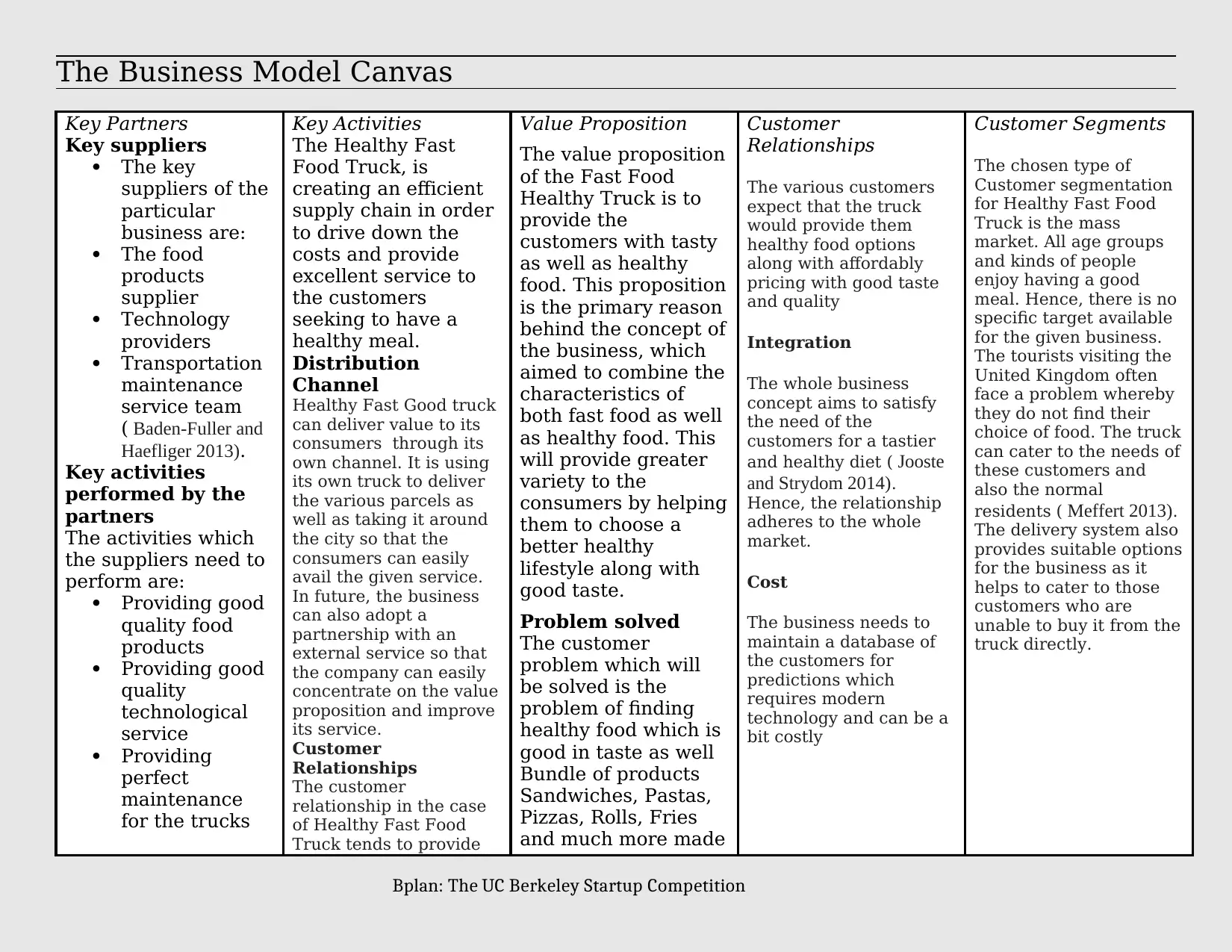
The Business Model Canvas
Key Partners
Key suppliers
The key
suppliers of the
particular
business are:
The food
products
supplier
Technology
providers
Transportation
maintenance
service team
( Baden-Fuller and
Haefliger 2013).
Key activities
performed by the
partners
The activities which
the suppliers need to
perform are:
Providing good
quality food
products
Providing good
quality
technological
service
Providing
perfect
maintenance
for the trucks
Key Activities
The Healthy Fast
Food Truck, is
creating an efficient
supply chain in order
to drive down the
costs and provide
excellent service to
the customers
seeking to have a
healthy meal.
Distribution
Channel
Healthy Fast Good truck
can deliver value to its
consumers through its
own channel. It is using
its own truck to deliver
the various parcels as
well as taking it around
the city so that the
consumers can easily
avail the given service.
In future, the business
can also adopt a
partnership with an
external service so that
the company can easily
concentrate on the value
proposition and improve
its service.
Customer
Relationships
The customer
relationship in the case
of Healthy Fast Food
Truck tends to provide
Value Proposition
The value proposition
of the Fast Food
Healthy Truck is to
provide the
customers with tasty
as well as healthy
food. This proposition
is the primary reason
behind the concept of
the business, which
aimed to combine the
characteristics of
both fast food as well
as healthy food. This
will provide greater
variety to the
consumers by helping
them to choose a
better healthy
lifestyle along with
good taste.
Problem solved
The customer
problem which will
be solved is the
problem of finding
healthy food which is
good in taste as well
Bundle of products
Sandwiches, Pastas,
Pizzas, Rolls, Fries
and much more made
Customer
Relationships
The various customers
expect that the truck
would provide them
healthy food options
along with affordably
pricing with good taste
and quality
Integration
The whole business
concept aims to satisfy
the need of the
customers for a tastier
and healthy diet ( Jooste
and Strydom 2014).
Hence, the relationship
adheres to the whole
market.
Cost
The business needs to
maintain a database of
the customers for
predictions which
requires modern
technology and can be a
bit costly
Customer Segments
The chosen type of
Customer segmentation
for Healthy Fast Food
Truck is the mass
market. All age groups
and kinds of people
enjoy having a good
meal. Hence, there is no
specific target available
for the given business.
The tourists visiting the
United Kingdom often
face a problem whereby
they do not find their
choice of food. The truck
can cater to the needs of
these customers and
also the normal
residents ( Meffert 2013).
The delivery system also
provides suitable options
for the business as it
helps to cater to those
customers who are
unable to buy it from the
truck directly.
Bplan: The UC Berkeley Startup Competition
Key Partners
Key suppliers
The key
suppliers of the
particular
business are:
The food
products
supplier
Technology
providers
Transportation
maintenance
service team
( Baden-Fuller and
Haefliger 2013).
Key activities
performed by the
partners
The activities which
the suppliers need to
perform are:
Providing good
quality food
products
Providing good
quality
technological
service
Providing
perfect
maintenance
for the trucks
Key Activities
The Healthy Fast
Food Truck, is
creating an efficient
supply chain in order
to drive down the
costs and provide
excellent service to
the customers
seeking to have a
healthy meal.
Distribution
Channel
Healthy Fast Good truck
can deliver value to its
consumers through its
own channel. It is using
its own truck to deliver
the various parcels as
well as taking it around
the city so that the
consumers can easily
avail the given service.
In future, the business
can also adopt a
partnership with an
external service so that
the company can easily
concentrate on the value
proposition and improve
its service.
Customer
Relationships
The customer
relationship in the case
of Healthy Fast Food
Truck tends to provide
Value Proposition
The value proposition
of the Fast Food
Healthy Truck is to
provide the
customers with tasty
as well as healthy
food. This proposition
is the primary reason
behind the concept of
the business, which
aimed to combine the
characteristics of
both fast food as well
as healthy food. This
will provide greater
variety to the
consumers by helping
them to choose a
better healthy
lifestyle along with
good taste.
Problem solved
The customer
problem which will
be solved is the
problem of finding
healthy food which is
good in taste as well
Bundle of products
Sandwiches, Pastas,
Pizzas, Rolls, Fries
and much more made
Customer
Relationships
The various customers
expect that the truck
would provide them
healthy food options
along with affordably
pricing with good taste
and quality
Integration
The whole business
concept aims to satisfy
the need of the
customers for a tastier
and healthy diet ( Jooste
and Strydom 2014).
Hence, the relationship
adheres to the whole
market.
Cost
The business needs to
maintain a database of
the customers for
predictions which
requires modern
technology and can be a
bit costly
Customer Segments
The chosen type of
Customer segmentation
for Healthy Fast Food
Truck is the mass
market. All age groups
and kinds of people
enjoy having a good
meal. Hence, there is no
specific target available
for the given business.
The tourists visiting the
United Kingdom often
face a problem whereby
they do not find their
choice of food. The truck
can cater to the needs of
these customers and
also the normal
residents ( Meffert 2013).
The delivery system also
provides suitable options
for the business as it
helps to cater to those
customers who are
unable to buy it from the
truck directly.
Bplan: The UC Berkeley Startup Competition
Paraphrase This Document
Need a fresh take? Get an instant paraphrase of this document with our AI Paraphraser
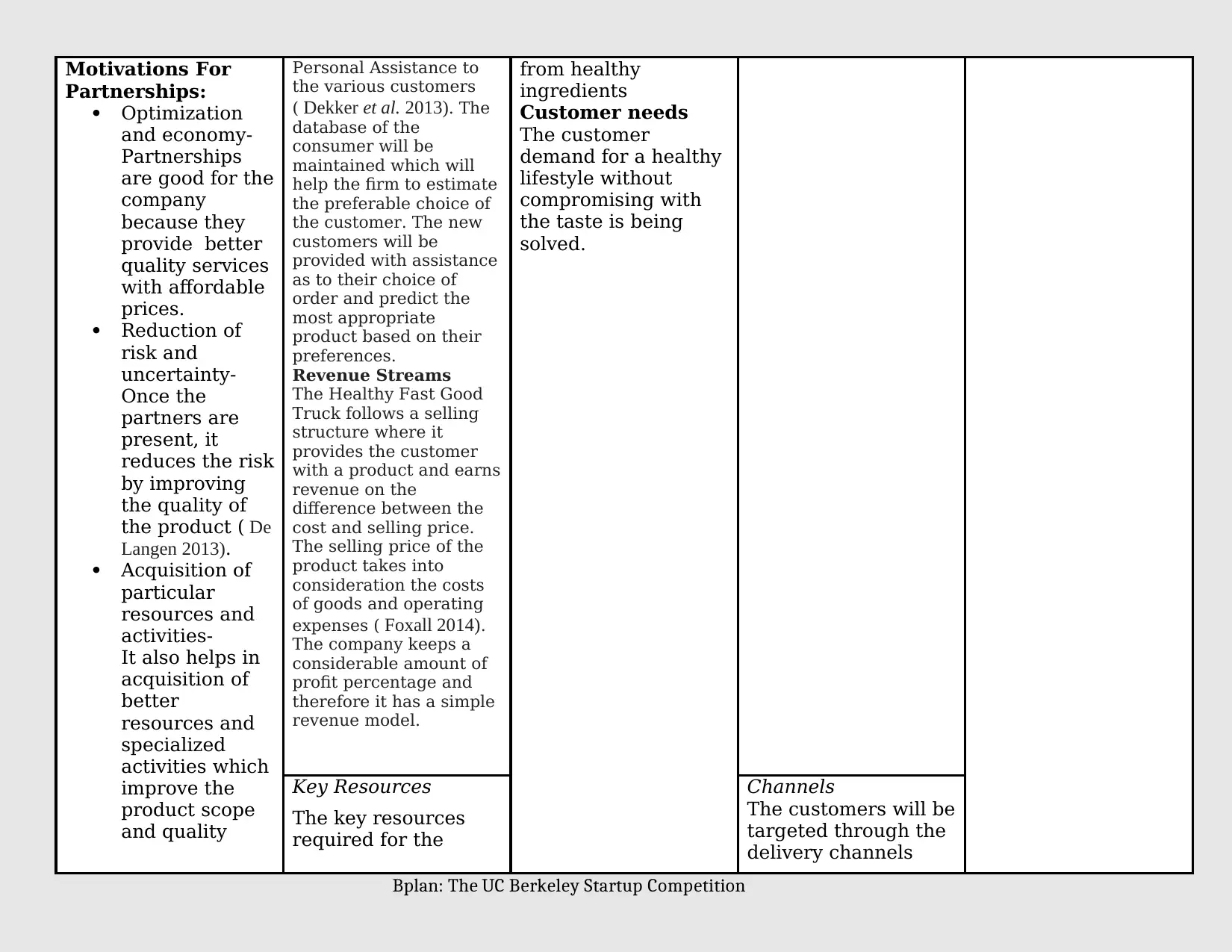
Motivations For
Partnerships:
Optimization
and economy-
Partnerships
are good for the
company
because they
provide better
quality services
with affordable
prices.
Reduction of
risk and
uncertainty-
Once the
partners are
present, it
reduces the risk
by improving
the quality of
the product ( De
Langen 2013).
Acquisition of
particular
resources and
activities-
It also helps in
acquisition of
better
resources and
specialized
activities which
improve the
product scope
and quality
Personal Assistance to
the various customers
( Dekker et al. 2013). The
database of the
consumer will be
maintained which will
help the firm to estimate
the preferable choice of
the customer. The new
customers will be
provided with assistance
as to their choice of
order and predict the
most appropriate
product based on their
preferences.
Revenue Streams
The Healthy Fast Good
Truck follows a selling
structure where it
provides the customer
with a product and earns
revenue on the
difference between the
cost and selling price.
The selling price of the
product takes into
consideration the costs
of goods and operating
expenses ( Foxall 2014).
The company keeps a
considerable amount of
profit percentage and
therefore it has a simple
revenue model.
from healthy
ingredients
Customer needs
The customer
demand for a healthy
lifestyle without
compromising with
the taste is being
solved.
Key Resources
The key resources
required for the
Channels
The customers will be
targeted through the
delivery channels
Bplan: The UC Berkeley Startup Competition
Partnerships:
Optimization
and economy-
Partnerships
are good for the
company
because they
provide better
quality services
with affordable
prices.
Reduction of
risk and
uncertainty-
Once the
partners are
present, it
reduces the risk
by improving
the quality of
the product ( De
Langen 2013).
Acquisition of
particular
resources and
activities-
It also helps in
acquisition of
better
resources and
specialized
activities which
improve the
product scope
and quality
Personal Assistance to
the various customers
( Dekker et al. 2013). The
database of the
consumer will be
maintained which will
help the firm to estimate
the preferable choice of
the customer. The new
customers will be
provided with assistance
as to their choice of
order and predict the
most appropriate
product based on their
preferences.
Revenue Streams
The Healthy Fast Good
Truck follows a selling
structure where it
provides the customer
with a product and earns
revenue on the
difference between the
cost and selling price.
The selling price of the
product takes into
consideration the costs
of goods and operating
expenses ( Foxall 2014).
The company keeps a
considerable amount of
profit percentage and
therefore it has a simple
revenue model.
from healthy
ingredients
Customer needs
The customer
demand for a healthy
lifestyle without
compromising with
the taste is being
solved.
Key Resources
The key resources
required for the
Channels
The customers will be
targeted through the
delivery channels
Bplan: The UC Berkeley Startup Competition
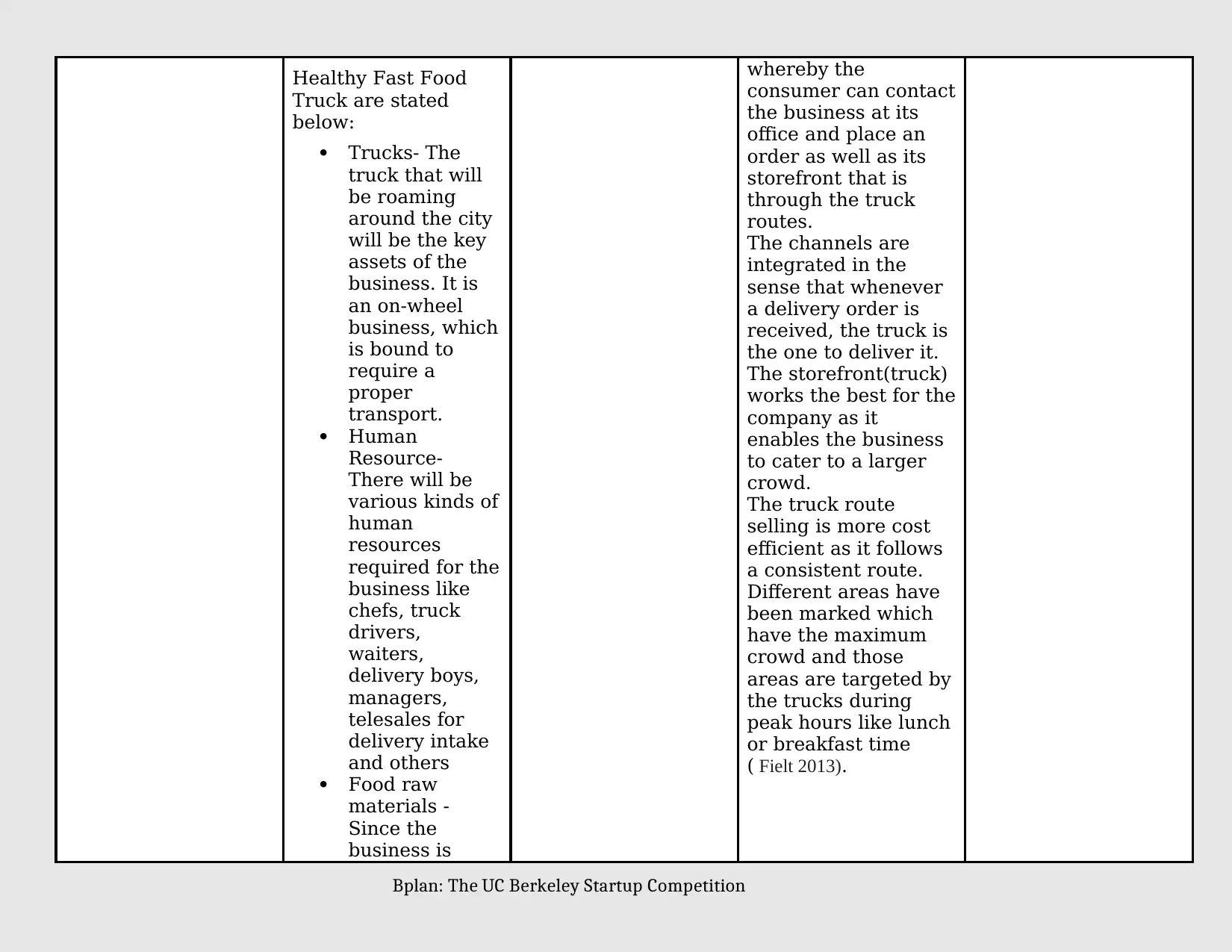
Healthy Fast Food
Truck are stated
below:
Trucks- The
truck that will
be roaming
around the city
will be the key
assets of the
business. It is
an on-wheel
business, which
is bound to
require a
proper
transport.
Human
Resource-
There will be
various kinds of
human
resources
required for the
business like
chefs, truck
drivers,
waiters,
delivery boys,
managers,
telesales for
delivery intake
and others
Food raw
materials -
Since the
business is
whereby the
consumer can contact
the business at its
office and place an
order as well as its
storefront that is
through the truck
routes.
The channels are
integrated in the
sense that whenever
a delivery order is
received, the truck is
the one to deliver it.
The storefront(truck)
works the best for the
company as it
enables the business
to cater to a larger
crowd.
The truck route
selling is more cost
efficient as it follows
a consistent route.
Different areas have
been marked which
have the maximum
crowd and those
areas are targeted by
the trucks during
peak hours like lunch
or breakfast time
( Fielt 2013).
Bplan: The UC Berkeley Startup Competition
Truck are stated
below:
Trucks- The
truck that will
be roaming
around the city
will be the key
assets of the
business. It is
an on-wheel
business, which
is bound to
require a
proper
transport.
Human
Resource-
There will be
various kinds of
human
resources
required for the
business like
chefs, truck
drivers,
waiters,
delivery boys,
managers,
telesales for
delivery intake
and others
Food raw
materials -
Since the
business is
whereby the
consumer can contact
the business at its
office and place an
order as well as its
storefront that is
through the truck
routes.
The channels are
integrated in the
sense that whenever
a delivery order is
received, the truck is
the one to deliver it.
The storefront(truck)
works the best for the
company as it
enables the business
to cater to a larger
crowd.
The truck route
selling is more cost
efficient as it follows
a consistent route.
Different areas have
been marked which
have the maximum
crowd and those
areas are targeted by
the trucks during
peak hours like lunch
or breakfast time
( Fielt 2013).
Bplan: The UC Berkeley Startup Competition
⊘ This is a preview!⊘
Do you want full access?
Subscribe today to unlock all pages.

Trusted by 1+ million students worldwide
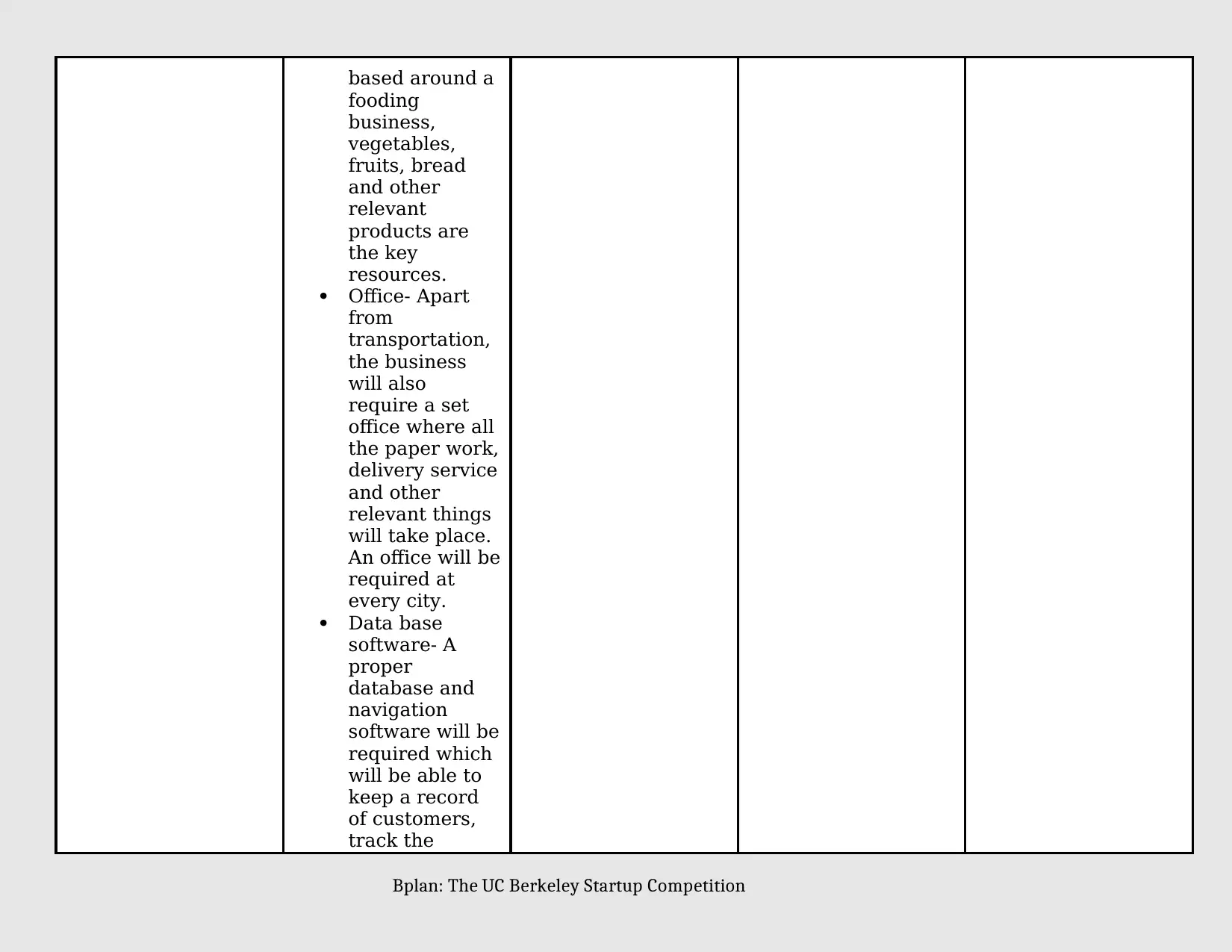
based around a
fooding
business,
vegetables,
fruits, bread
and other
relevant
products are
the key
resources.
Office- Apart
from
transportation,
the business
will also
require a set
office where all
the paper work,
delivery service
and other
relevant things
will take place.
An office will be
required at
every city.
Data base
software- A
proper
database and
navigation
software will be
required which
will be able to
keep a record
of customers,
track the
Bplan: The UC Berkeley Startup Competition
fooding
business,
vegetables,
fruits, bread
and other
relevant
products are
the key
resources.
Office- Apart
from
transportation,
the business
will also
require a set
office where all
the paper work,
delivery service
and other
relevant things
will take place.
An office will be
required at
every city.
Data base
software- A
proper
database and
navigation
software will be
required which
will be able to
keep a record
of customers,
track the
Bplan: The UC Berkeley Startup Competition
Paraphrase This Document
Need a fresh take? Get an instant paraphrase of this document with our AI Paraphraser
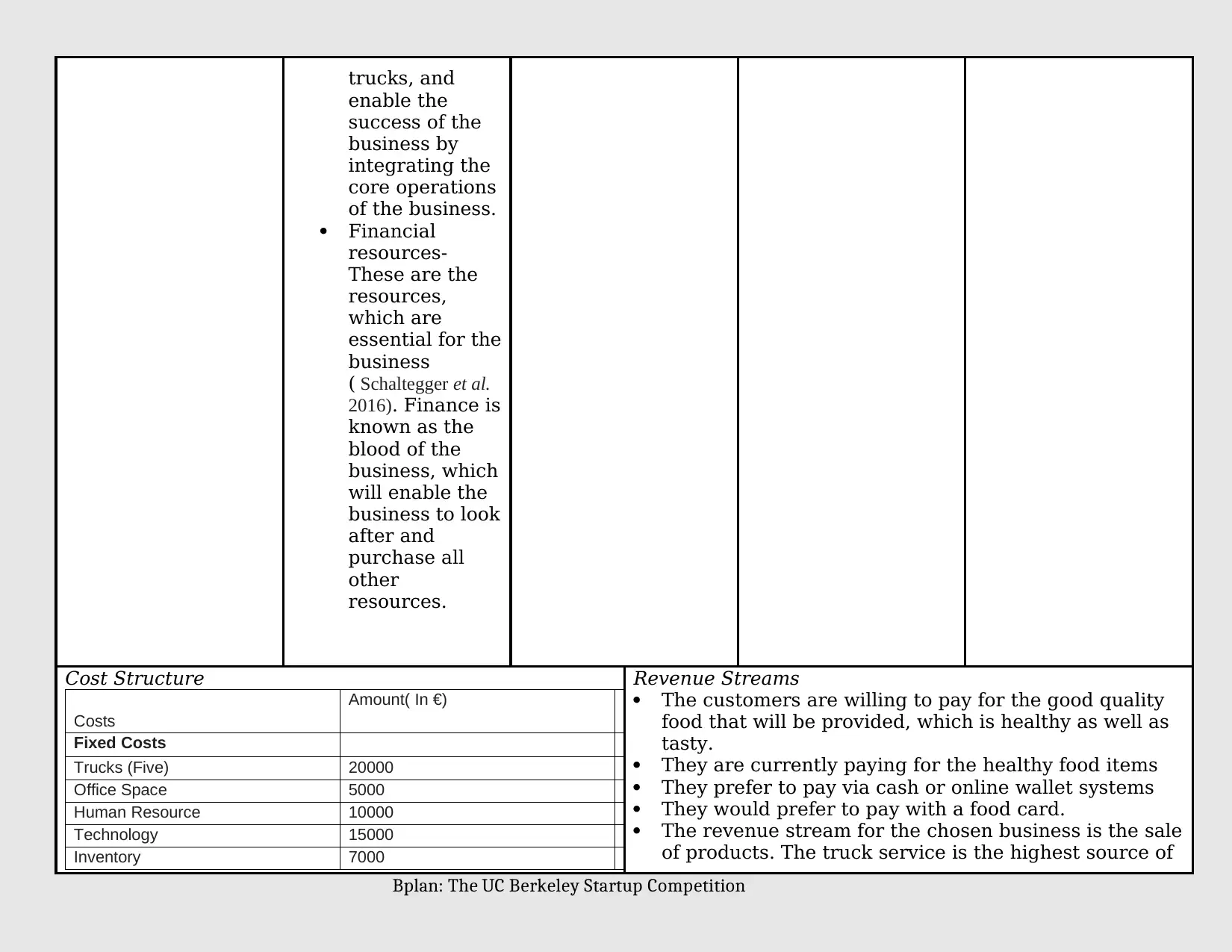
trucks, and
enable the
success of the
business by
integrating the
core operations
of the business.
Financial
resources-
These are the
resources,
which are
essential for the
business
( Schaltegger et al.
2016). Finance is
known as the
blood of the
business, which
will enable the
business to look
after and
purchase all
other
resources.
Cost Structure
Costs
Amount( In €)
Fixed Costs
Trucks (Five) 20000
Office Space 5000
Human Resource 10000
Technology 15000
Inventory 7000
Revenue Streams
The customers are willing to pay for the good quality
food that will be provided, which is healthy as well as
tasty.
They are currently paying for the healthy food items
They prefer to pay via cash or online wallet systems
They would prefer to pay with a food card.
The revenue stream for the chosen business is the sale
of products. The truck service is the highest source of
Bplan: The UC Berkeley Startup Competition
enable the
success of the
business by
integrating the
core operations
of the business.
Financial
resources-
These are the
resources,
which are
essential for the
business
( Schaltegger et al.
2016). Finance is
known as the
blood of the
business, which
will enable the
business to look
after and
purchase all
other
resources.
Cost Structure
Costs
Amount( In €)
Fixed Costs
Trucks (Five) 20000
Office Space 5000
Human Resource 10000
Technology 15000
Inventory 7000
Revenue Streams
The customers are willing to pay for the good quality
food that will be provided, which is healthy as well as
tasty.
They are currently paying for the healthy food items
They prefer to pay via cash or online wallet systems
They would prefer to pay with a food card.
The revenue stream for the chosen business is the sale
of products. The truck service is the highest source of
Bplan: The UC Berkeley Startup Competition
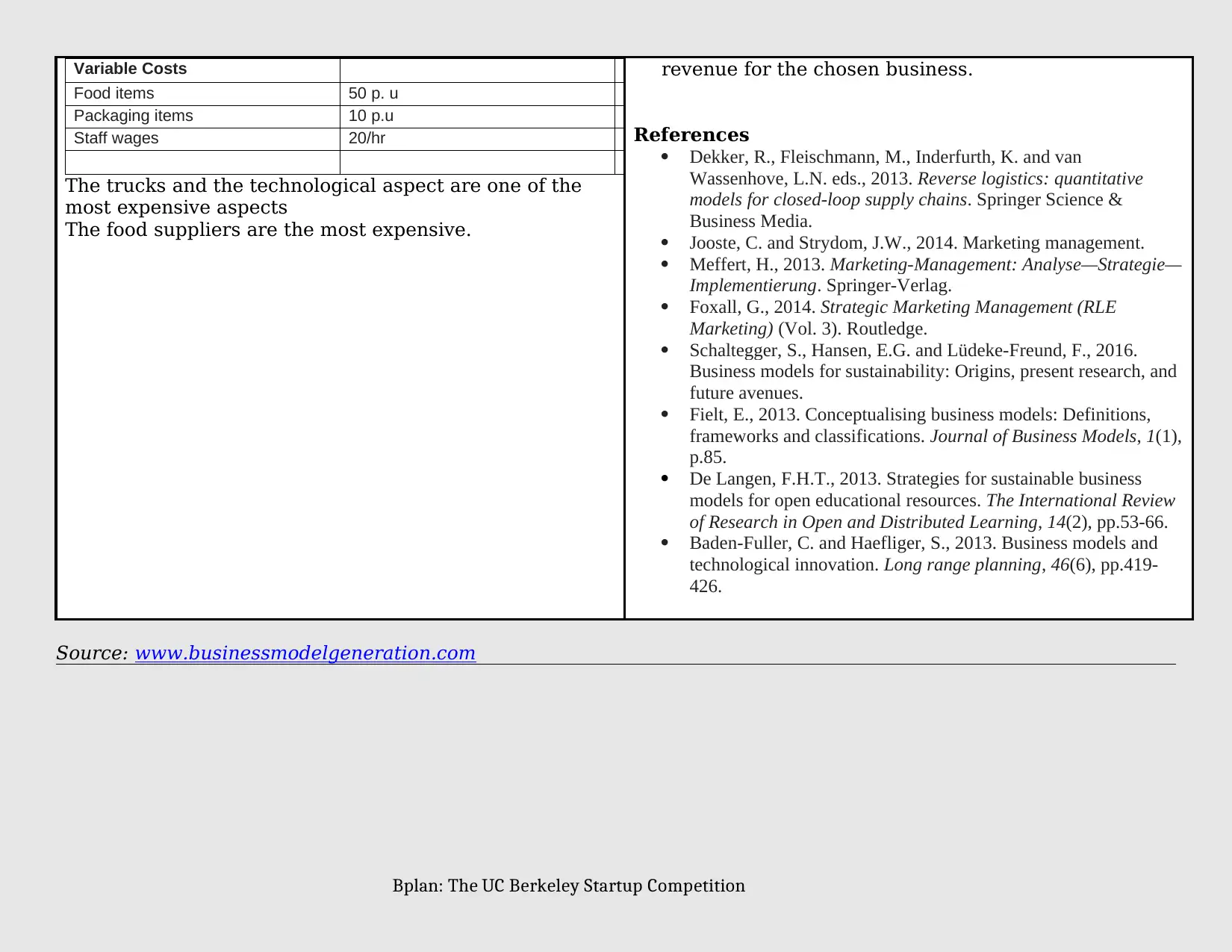
Variable Costs
Food items 50 p. u
Packaging items 10 p.u
Staff wages 20/hr
The trucks and the technological aspect are one of the
most expensive aspects
The food suppliers are the most expensive.
revenue for the chosen business.
References
Dekker, R., Fleischmann, M., Inderfurth, K. and van
Wassenhove, L.N. eds., 2013. Reverse logistics: quantitative
models for closed-loop supply chains. Springer Science &
Business Media.
Jooste, C. and Strydom, J.W., 2014. Marketing management.
Meffert, H., 2013. Marketing-Management: Analyse—Strategie—
Implementierung. Springer-Verlag.
Foxall, G., 2014. Strategic Marketing Management (RLE
Marketing) (Vol. 3). Routledge.
Schaltegger, S., Hansen, E.G. and Lüdeke-Freund, F., 2016.
Business models for sustainability: Origins, present research, and
future avenues.
Fielt, E., 2013. Conceptualising business models: Definitions,
frameworks and classifications. Journal of Business Models, 1(1),
p.85.
De Langen, F.H.T., 2013. Strategies for sustainable business
models for open educational resources. The International Review
of Research in Open and Distributed Learning, 14(2), pp.53-66.
Baden-Fuller, C. and Haefliger, S., 2013. Business models and
technological innovation. Long range planning, 46(6), pp.419-
426.
Source: www.businessmodelgeneration.com
Bplan: The UC Berkeley Startup Competition
Food items 50 p. u
Packaging items 10 p.u
Staff wages 20/hr
The trucks and the technological aspect are one of the
most expensive aspects
The food suppliers are the most expensive.
revenue for the chosen business.
References
Dekker, R., Fleischmann, M., Inderfurth, K. and van
Wassenhove, L.N. eds., 2013. Reverse logistics: quantitative
models for closed-loop supply chains. Springer Science &
Business Media.
Jooste, C. and Strydom, J.W., 2014. Marketing management.
Meffert, H., 2013. Marketing-Management: Analyse—Strategie—
Implementierung. Springer-Verlag.
Foxall, G., 2014. Strategic Marketing Management (RLE
Marketing) (Vol. 3). Routledge.
Schaltegger, S., Hansen, E.G. and Lüdeke-Freund, F., 2016.
Business models for sustainability: Origins, present research, and
future avenues.
Fielt, E., 2013. Conceptualising business models: Definitions,
frameworks and classifications. Journal of Business Models, 1(1),
p.85.
De Langen, F.H.T., 2013. Strategies for sustainable business
models for open educational resources. The International Review
of Research in Open and Distributed Learning, 14(2), pp.53-66.
Baden-Fuller, C. and Haefliger, S., 2013. Business models and
technological innovation. Long range planning, 46(6), pp.419-
426.
Source: www.businessmodelgeneration.com
Bplan: The UC Berkeley Startup Competition
⊘ This is a preview!⊘
Do you want full access?
Subscribe today to unlock all pages.

Trusted by 1+ million students worldwide
1 out of 6
Related Documents
Your All-in-One AI-Powered Toolkit for Academic Success.
+13062052269
info@desklib.com
Available 24*7 on WhatsApp / Email
![[object Object]](/_next/static/media/star-bottom.7253800d.svg)
Unlock your academic potential
Copyright © 2020–2025 A2Z Services. All Rights Reserved. Developed and managed by ZUCOL.




